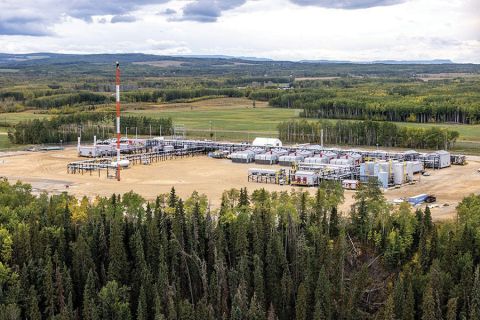U.S. natural gas output in the lower 48 states increased to 80.3 billion cubic feet per day (Bcf/d) in August from 79.6 Bcf/d in July, the U.S. Energy Information Administration (EIA) said in its monthly 914 production report.
That was the first increase in monthly production since February.
Gas production in August was down almost 2% from year-earlier levels of 81.9 Bcf/d, the EIA said.
The increase occurred as drillers started to return to the well pad as oil prices climbed over $50 a barrel in recent months. Most of the new drilling was in the Permian shale in west Texas and eastern New Mexico.
Monthly production in the lower 48 states peaked in February at 82.6 Bcf/d.
Output was mixed in the biggest producing lower 48 states, with Texas, the largest, down 0.1% to 22 Bcf/d in August from July. That is the state's lowest level of monthly output since March 2012.
Production in Pennsylvania also declined 0.1% to 14.3 Bcf/d in August from July.
In Oklahoma, meanwhile, August output increased 1.3% from July to 6.7 Bcf/d.
Many analysts and the EIA have projected U.S. gas production in 2016 will decline for the first time since the start of the shale revolution a decade ago as low energy prices reduced drilling activity.
U.S. gas production last dropped in 2005 when Hurricanes Katrina and Rita slammed into the Gulf Coast, damaging energy infrastructure along the Gulf of Mexico that had been supplying more than 20% of the nation's gas.
Since then, producers have figured out how to use horizontal drilling and hydraulic fracturing technologies to unlock more of the gas trapped in shale rocks.
Today, the seven biggest U.S. shale fields provide more than 60% of the nation's dry gas production, while the Gulf of Mexico accounts for just 4% of the total.
Recommended Reading
With Montney Production Set to Grow, US E&Ps Seize Opportunities
2024-10-02 - Canada’s Montney Shale play has already attracted U.S. companies Ovintiv, Murphy and ConocoPhillips while others, including private equity firms, continue to weigh their options.
US Drillers Cut Oil, Gas Rigs for Fourth Week in a Row
2024-09-06 - The oil and gas rig count fell by one to 582 in the week to Sept. 6, the lowest since June.
US Drillers Add Oil, Gas Rigs for First Time in Five Weeks
2024-09-13 - The oil and gas rig count rose by eight in the week to Sept. 13 to 590, returning to mid-June levels. The increase was the biggest since the week to Sept. 15, 2023.
US Drillers Cut Oil, Gas Rigs for Second Week in a Row
2024-09-27 - The oil and gas rig count fell by 1 to 587 in the week to Sept. 27, the lowest since early September.
Northern’s O’Grady: Most of ‘Best’ Acres ‘Already Been Bought’
2024-10-24 - Adding new-well inventory going forward will require “exploration or other creative measures,” said Nick O’Grady, whose Northern Oil and Gas holds interests in 10,000 Lower 48 wells.


